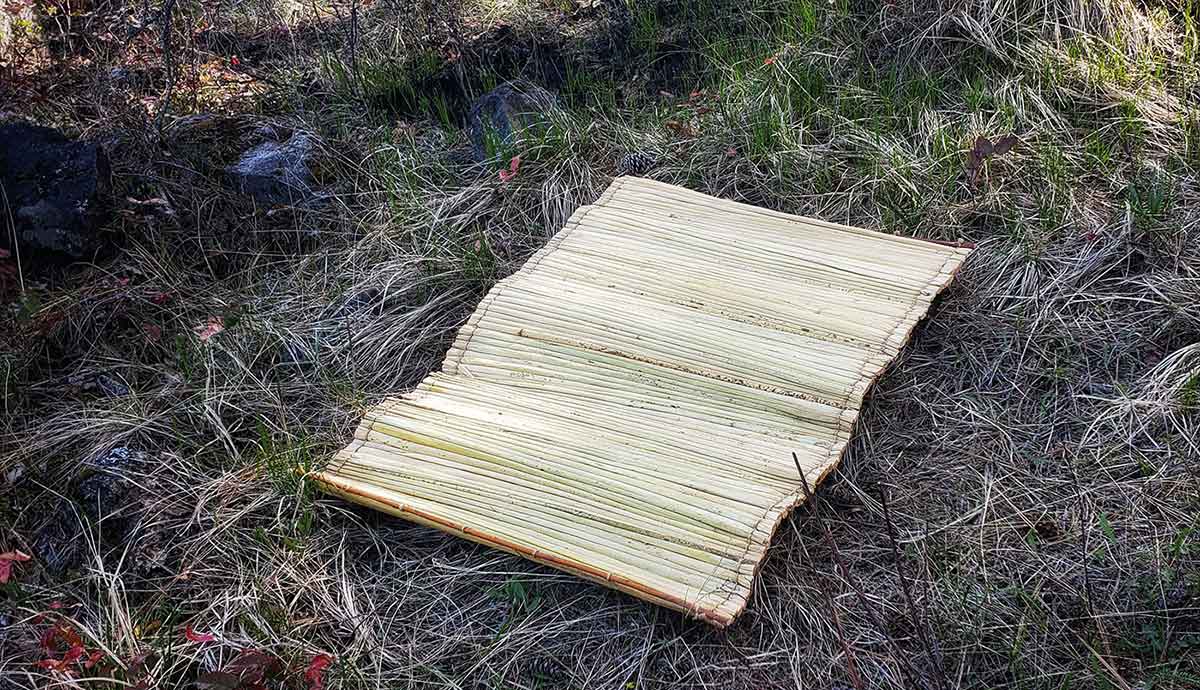
Cedar Bark Gathering Bucket (mxiłp), Patti Bailey, qʷn̓qʷin̓x̌n̓, photo: Diane Beals. This is a berry gathering basket made in the forest where the western red cedar grow. The bark is carefully pulled from a young cedar during the Spring when the sap is running. This basket is utilized by the Interior Salish people. Basket stitching and rim is sewn with cedar bark strips.
Patti
Bailey
qʷn̓qʷin̓x̌n̓
Traditional and Contemporary Weavings: As an adult student of traditional and contemporary weaving, I most enjoy working with local native plants and trees and other complementary contemporary contrasts. Gathering, preparation and weaving with cedar bark and wetland plants has led me onto paths of knowledge, patterns, and techniques of our ancestors.
I have been fortunate to have learned from Dawn Walden, Native Ojibwa Master Basket Weaver, and the late Arlie Cooper, an extraordinary Colville Tribal Elder Weaver, and our fellow friends and family and the larger Tribal basket weaving community.
Learning, understanding, and practicing the harvesting of native materials is a life-long learning journey. Working with cedar bark, cedar root, tules, sedge, gourds and Indian hemp requires seasonal patience, but the materials open a window to the past with beauty and the tremendous utility of basketry.

Tule Mat (tukʷtán̓), Patti Bailey, qʷn̓qʷin̓x̌n̓, photo: Diane Beals.
Woven from the wetland plant tule or bulrush, the optimal time to pull tule is in the late summer when they are most mature and before they freeze. The structure of the tule repels water, is buoyant and lightweight to roll up for transport. Its buoyancy kept many a sturgeon nosed canoe upright in the river. Tule mats were historically used for a multitude of essential utilitarian needs including shelters, sleeping mats, burial mats and other ceremonial uses.

Patti Bailey, qʷn̓qʷin̓x̌n̓ is a member of the Confederated Tribes of the Colville Reservation sn̓ʕay̓čkstx (Sinixt), in Inchelium, Washington and practices traditional and contemporary weaving. The last twenty years of her career were spent working as an Environmental Planner for the Colville Tribal government to develop and implement strategies and cooperative working relationships to deal with decades of impact to river communities, Tribal people, and natural resources from Columbia River pollution sources in Canada.
Patti shares this story Sat Jun 19, 11am, as part of the Overburden programming.
Kootenay Gallery of Art
120 Heritage Way
Castlegar, BC V1N 4M5
kootenaygallery[dot]telus.net
250-365-3337
Oxygen Art Centre
#3-320 Vernon St. (alley entrance)
Nelson, B.C. V1L4E4
info[dot]oxygenartcentre.org
250-352-6322
We acknowledge with gratitude that our art spaces are located on the unceded traditional territory of the sn̓ʕay̓ckstx (Sinixt Arrow Lakes), Sylix (Okanagan Nation Alliance) and Ktunaxa (specifically Yaqan Nukij Lower Kootenay Band peoples). We recognize the enduring presence of First Nations people on these lands and that they are home to Métis and many diverse Indigenous persons.